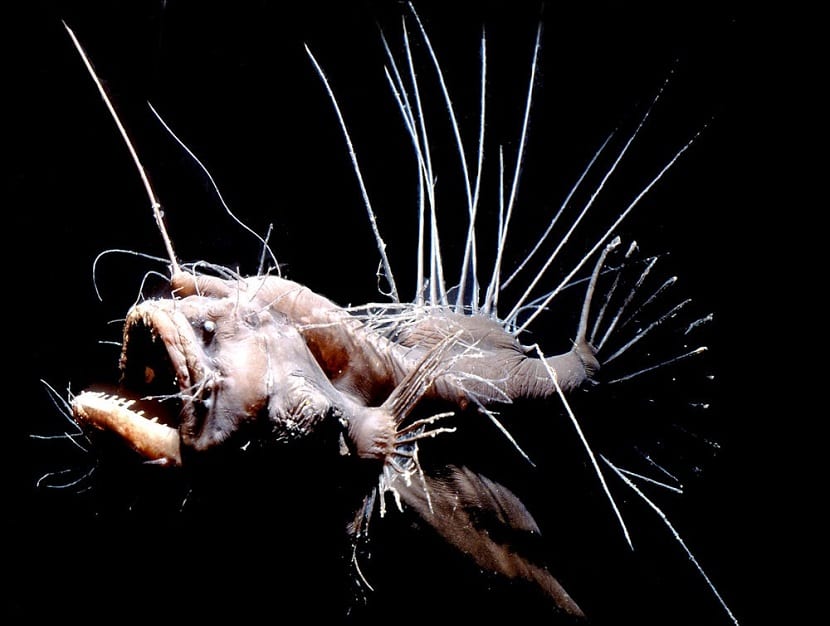
Have you ever heard of the monkfish. All members of the order are called pe monkfish lophiiformes. They are bony fish with an unconventional appearance and are often scary to see as they do not seem friendly at all.
Monkfish is known as one of the ugliest fish that exist given its appearance and characteristics. This fish has characteristics that make it very peculiar. Do you want to know more about monkfish?
Monkfish characteristics
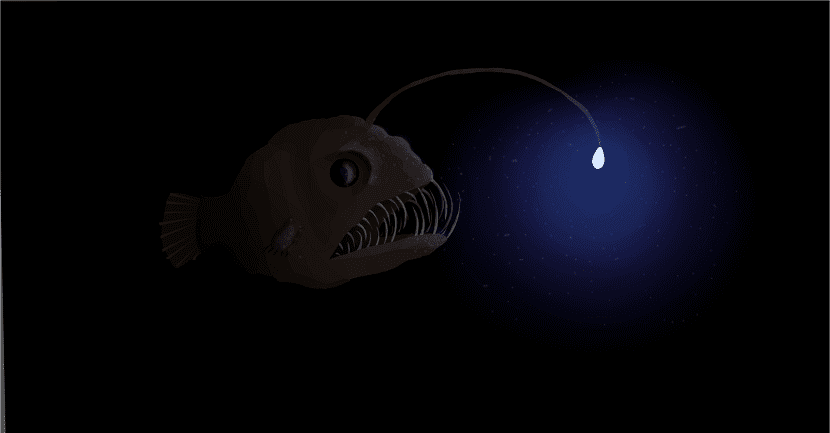
As mentioned before, it belongs to the order lophiiformes. These fish usually have a very unconventional appearance that makes them characteristic. This order de peces It is divided into 5 suborders: Lophioidei, Antennarioidei, Chaunacoidei, Ogcocephaloidei, and Ceratioidei.
Although they are called one of the ugliest animals that exist, their morphology has an explanation. This body shape it is adapted to survive in the inhospitable depths of the ocean. In the depths of the ocean there is hardly any sunlight, so the nutrients are more scarce. The fight for survival is much more complex since there are many predatory species.
As for its characteristic body, it has a very broad head and a flattened body that tapers towards the tail. One of the scariest things about these fish is their teeth. Its mouth is shaped like a half moon and the teeth are sharp and shaped inwards. They normally have a brown or dark gray body color and rough, rough, scaleless skin.
Due to the conditions in which you live, has thin and flexible bones which allows it to open its mouth wide enough to be able to engulf its prey. To avoid being eaten or putting up some kind of resistance, they have long spines on their heads. They have the dorsal and ventral fins located on the back of the tail. Some species of monkfish have their fins modified to better adapt to the seabed and to be able to walk on it. The size ranges from 20 centimeters to 1 meter in length while the weight is about 27-45 kilograms.
One of the characteristics of the monkfish that makes it so special is the piece of spine that protrudes above the mouth. It looks like it's an antenna and uses it as bait to attract prey. This organ in some species of female anglerfish has luminescence. This is due to the symbiotic bacteria that inhabit the organ.
Monkfish distribution area
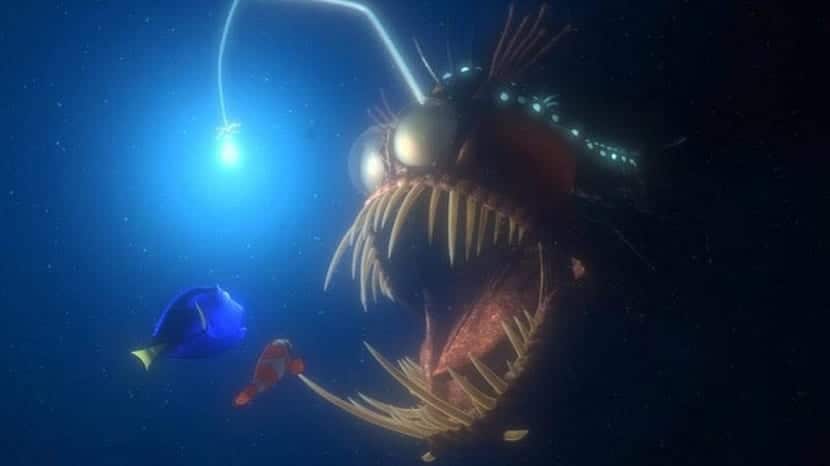
Monkfish reference in Finding Nemo
Although most monkfish are in the Atlantic Ocean and Antarctica, there are about 300 species around the world. They can inhabit depths of up to 1.600 meters. Some species live in shallower waters, but they are more rare.
As we have mentioned before, the survival of the monkfish is made difficult due to the ecosystem in which it lives. Basically, the lack of light is the most limiting variable in these places. With hardly any sunlight, there are no plants that photosynthesize or vision to be able to move and better hunt their prey.
Monkfish behavior
These fish are usually solitary. In order to better adapt to deep sea environments, they have developed a symbiotic relationship with the bacteria that live around their "antenna." The relationship consists of a mutualism in which the two win something. On the one hand, monkfish benefit from the light provided by their organ to be able to see on the seabed and, on the other hand, bacteria are capable of synthesizing chemical elements that are necessary to be able to emit luminescence, which if they were far from the body of the angler fish, they could not.
Another curious aspect that this fish has is the relationship between males and females. The males are generally smaller and, in many cases, these become her parasitic companion. This usually occurs when anglerfish are young or unable to swim, they can cling to a female by gouging their teeth. If this relationship is maintained for a time, the male is able to fuse with the female, connecting his skin and his blood circulation. When this happens, you lose your eyes and internal organs other than the reproductive organs. Thus, it is not uncommon for a female to have 6 or more males fused to her body.
Monkfish feeding
These fish are predators of other species de peces. In order to hunt them down, they use their luminescent organ. When prey makes contact with the bait, the anglerfish quickly opens its mouth and devours it. Thanks to the very flexible bones they have, they are capable of swallowing prey that is twice their size.
Monkfish reproduction

Due to the dark environment in which they live and the difficulty in meeting other fish, it is really problematic for anglerfish to find a mate to mate with. For two monkfish to meet each other is quite unusual. Therefore, when they reproduce they do so sporadically. The male lives for the sole purpose of reproducing and when he finds a female he does not hesitate to merge with her, thus becoming a parasite in exchange for sperm for his partner.
Although not all monkfish reproduce in this way. There are some species that are able to maintain a temporary sexual attachment without having to fuse their tissues.
Whatever the mode of reproduction, the female spawns in the sea on a gelatinous and transparent layer. This layer has dimensions of 25 cm wide and 10 meters long. Each egg floats in an individual chamber that has openings for the water to circulate inside. When the eggs hatch, thousands of larvae hatch with elongated pelvic fins, shaped like filaments.
Similarities and differences with frogfish
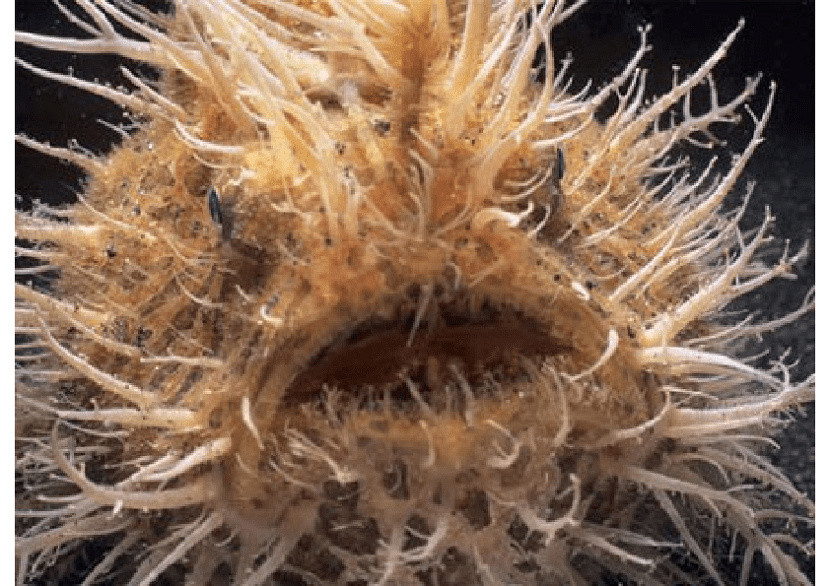
The toad fish has some similarities with the monkfish, although it also has great differences. Both are great predators and have an organ that serves as bait for their prey. The difference between the two is that frogfish blend into the environment to distract their prey and look like they are sea sponges. With its bait organ it attracts prey and, like monkfish, it is able to open its mouth so wide that it could swallow prey larger than itself. While monkfish attract prey with light, the frogfish has to hide from them to attack by surprise.
The organ used as bait is an elongation of the spine that looks like a worm or a small fish. With this you can attract prey as if it were a fishing rod. Their body, unlike the monkfish, is covered in quills, irregularities, and warts that allow them to blend in with sponges, sea squirts, corals, and even rocks.

Another difference that toadfish and monkfish have is poison. The toadfish has a poison to defend itself from other prey, in addition to mimicking the environment. Monkfish is the opposite: he seeks to attract the attention of the prey so that they go towards him.
Toadfish have no symbiont relationship with any species of bacteria or other species. de peces.
Toadfish are found in tropical and subtropical regions of the Atlantic and Pacific, Indian Ocean and the Red Sea. These species do not live as deep as the seabed as monkfish.
What threats does the monkfish have?
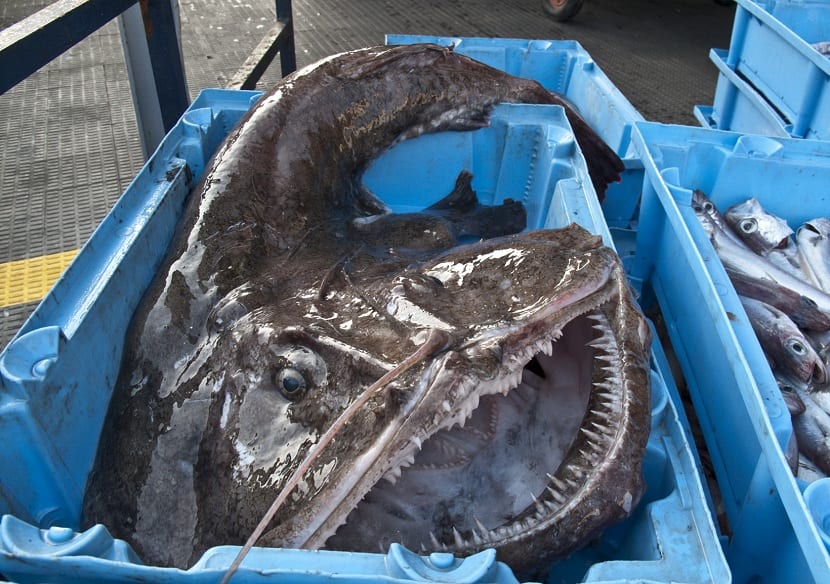
Still living in the depths of the seabed and about 1.600 meters deep, monkfish are threatened by humans. Although they are one of the ugliest fish in the world, this is not what attracts humans, but their tasting and flavor. Monkfish is common in dishes made with its meat. In addition, in places like Japan and Korea they are considered a delicacy worth trying.
The American monkfish (Lophius americanus) and black-bellied monkfish are included on the Greenpeace Red List of Fishery Species, which indicates fish sold worldwide with a high probability of coming from unsustainable fisheries. In addition to overfishing, monkfish are also threatened in their natural environment. During the phenomenon El Niño swim to the surface and subsequently a large amount is seen floating de peces dead. This is due to fluctuations in water temperatures. Currently, the overfishing of these fish and the effects of climate change that cause increased water temperatures and acidification of the oceans, are threatening monkfish.
With this information you will be able to know a little more about these fish that, although very ugly on the outside, are capable of adapting and surviving in very hostile environments and, in addition, their flavor is highly demanded in many countries where it is a delicacy to taste their meat.
Wow, amazing article!